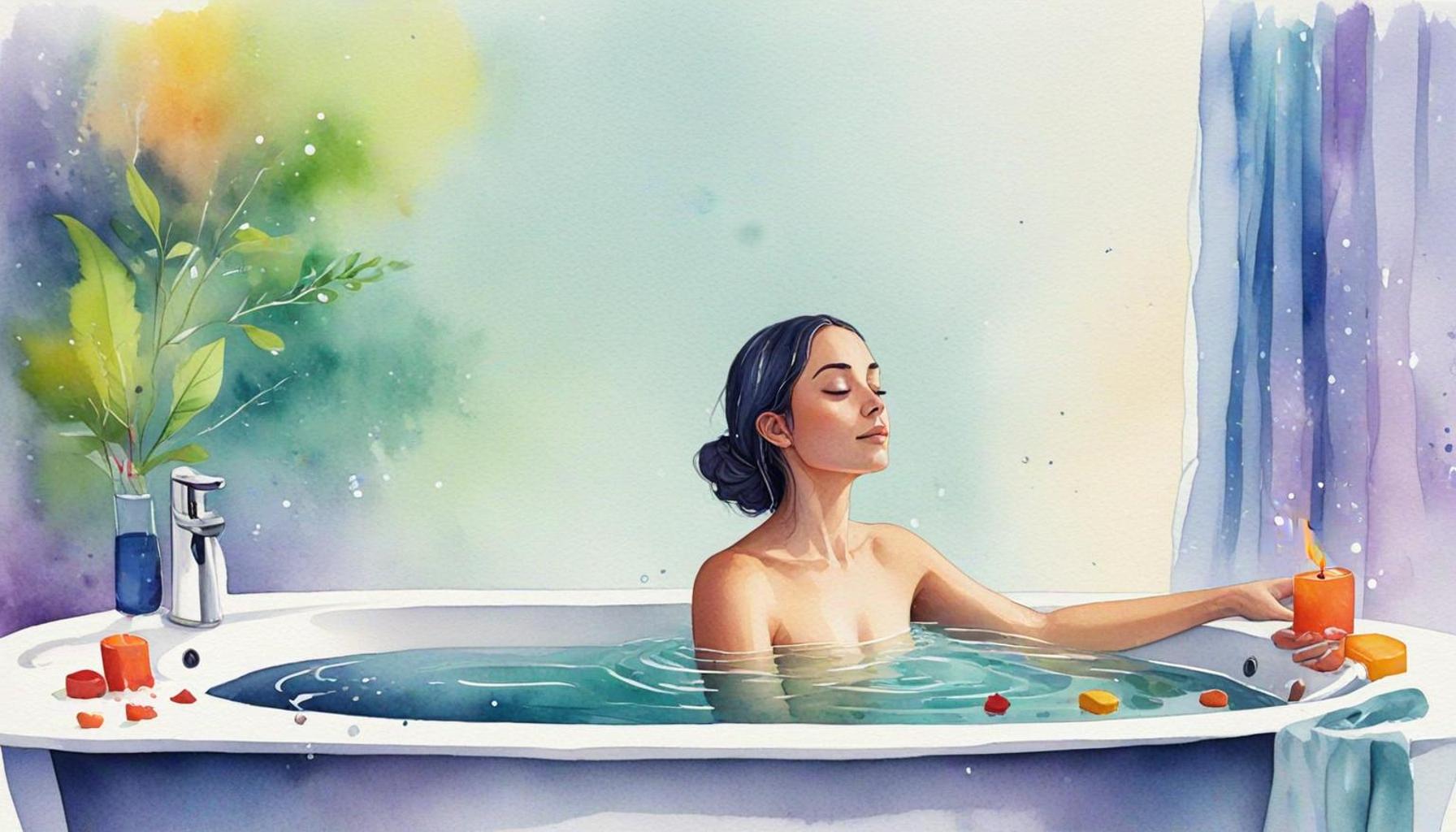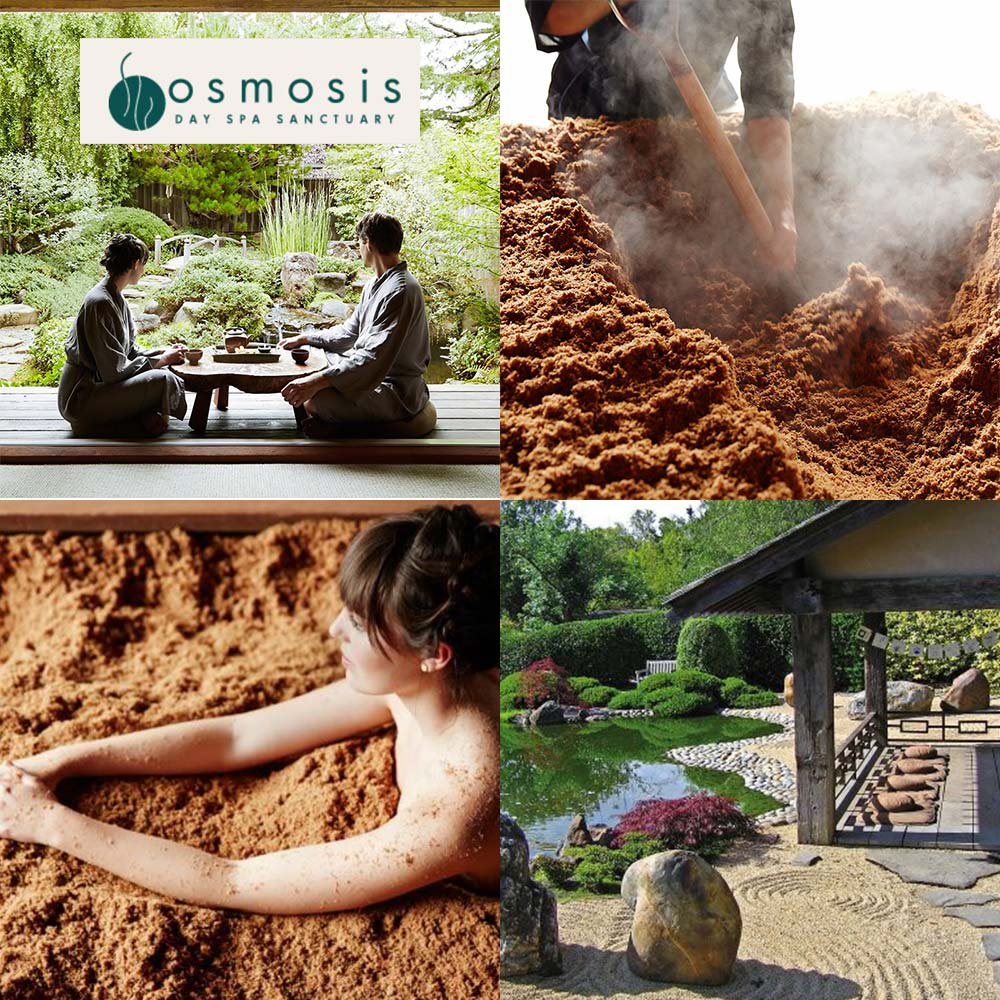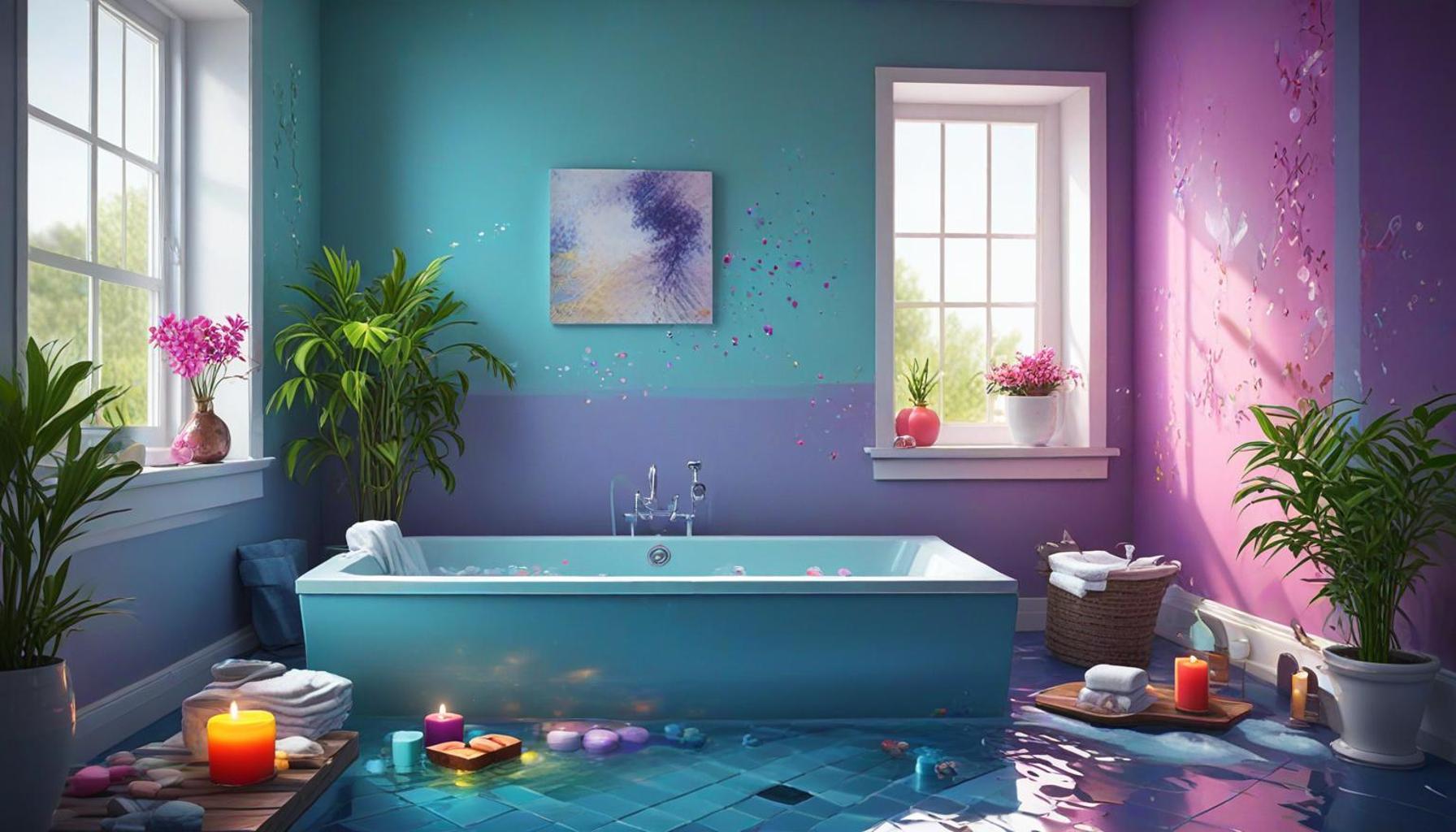Exploring the Connection Between Guided Visualization and Self-Acceptance in Bath Meditation

The Transformative Journey of Bath Meditation
In today’s fast-paced society, individuals are continuously searching for ways to cultivate inner peace and enhance their sense of self. One powerful method that has garnered attention is the gentle practice of bath meditation, particularly when combined with guided visualization techniques. This harmonious blend not only promotes relaxation but also unveils deeper layers of self-acceptance and emotional clarity.
Guided visualization refers to a meditative technique that harnesses the power of mental imagery to create a desired state of mind. When applied during bath meditation, this approach significantly enhances relaxation, thereby allowing participants to escape the burdens of daily life, if only for a moment. For anyone in Nigeria, where the hustle and bustle can often feel overwhelming, this technique offers a much-needed respite.
Benefits of Bath Meditation with Guided Visualization
The benefits of integrating guided visualization with bath meditation are numerous. Here are some key features to consider:
- Enhanced Relaxation: By dimming the lights and adding soothing scents like lavender or eucalyptus, you can cultivate a tranquil atmosphere that promotes deeper relaxation.
- Emotional Clarity: This practice encourages individuals to explore their feelings without judgment. Visualizing warm currents of water can help release pent-up emotions and clarify complex thoughts.
- Self-Reflection: Bath meditation provides a safe space for introspection. Many practitioners report gaining insights into their life goals and personal challenges while immersed in warm water.
In Nigeria, the increasing popularity of wellness circles has led many to explore these transformative practices, where the bath becomes a sacred space for personal growth. Imagine visualizing a serene beach at Tarkwa Bay while enveloped in the warm embrace of your bathtub—this experience is not just indulgent; it fosters an environment ripe for self-acceptance.
As we delve deeper into how guided visualization complements bath meditation, we begin to uncover its capacity to nurture emotional well-being. For instance, consider setting an intention before starting your bath meditation, such as inviting peace into your life. This simple act can set the tone for the entire experience, enhancing the connection between the mind and body.

Through this journey of exploration and practice, individuals can cultivate a profound sense of love and acceptance within themselves. Moreover, the integration of traditional Nigerian elements—like singing local music or incorporating natural herbs in the bath—can further enrich the experience, deepening the connection to one’s cultural roots.
Ultimately, the practice of bath meditation combined with guided visualization opens a gateway to improved emotional health, inviting individuals to discover the peaceful reservoir that lies within. It is an invitation to embrace oneself fully, fostering an environment for growth that reverberates beyond the bathroom and into daily life.
SEE ALSO: Click here to read another article
The Synergy of Visualization and Self-Discovery
To fully appreciate the significant role that guided visualization plays in enhancing self-acceptance during bath meditation, one must first understand the mechanics of both practices individually. Guided visualization, rooted in a variety of holistic traditions, involves using specific imagery to induce a desired psychological state. When intertwined with bath meditation, an age-old practice celebrated for its soothing properties, this combination can transform a simple bathing ritual into a profound journey of self-discovery.
The warm water of the bath serves not only as a medium for relaxation but also acts as a catalyst for introspection. In Nigeria, many individuals find solace in creative expressions. Imagine immersing oneself in a warm bath while imagining the picturesque landscapes of Nigeria, from the lush greens of Obudu Mountain Resort to the calming shores of Lekki Beach. Such vivid imagery can foster a strong sense of belonging and acceptance within oneself.
The engagement of the senses during this process amplifies the overall experience. Consider implementing the following elements to elevate bath meditation with guided visualization:
- Scents: Utilizing natural oils, such as shea butter or ginger, can evoke emotional responses that reinforce feelings of comfort and warmth.
- Temperature: The water’s warmth can signify emotional healing and relaxation, symbolizing the release of outdated self-perceptions.
- Sound: Incorporating gentle music, perhaps traditional Nigerian instruments like the talking drum, can ground the experience in cultural resonance, facilitating a deeper emotional bond.
As one steeps in the bath, guided visualization techniques can be employed to shift focus inward. Practitioners may envision a serene, inviting landscape, free from judgment or criticism, where they can explore their authentic selves without external pressures. This meditative approach encourages self-reflection, allowing individuals to confront issues of self-doubt or insecurity in a safe environment.
Furthermore, scientists have researched the positive impacts of guided imagery on mental health outcomes, suggesting that such techniques can improve emotional regulation and resilience. For instance, a study published in the Nigerian Journal of Psychological Research indicated that individuals who practiced visualization reported enhanced self-esteem and greater acceptance of their identities. This correlation is particularly vital in a multicultural society like Nigeria, where diverse backgrounds may influence self-perception significantly.
Ultimately, integrating guided visualization into bath meditation invites individuals on a journey toward self-acceptance. With each mindful session, practitioners uncover layers of self-love and appreciation that may have been obscured in the hustle and bustle of daily life. The bath becomes not just a place of physical cleansing but also an oasis for emotional rejuvenation—redefining what it means to truly accept oneself.
Exploring the Connection Between Guided Visualization and Self-Acceptance in Bath Meditation
Bath meditation serves as a transformative practice where individuals immerse themselves in both physical and mental landscapes, contributing significantly to overall well-being. One compelling aspect of this practice is the integration of guided visualization techniques, which can enhance the experience and promote deeper self-acceptance.Guided visualization in bath meditation involves using mental imagery to create vivid experiences, enabling individuals to picture serene environments that promote relaxation and mindfulness. This imaginative exercise can be exceptionally beneficial for self-acceptance, as it allows practitioners to confront their inner thoughts and feelings without judgment. By visualizing positive and calming scenarios, individuals can foster a sense of peace and connect more deeply with their authentic selves.Furthermore, introducing themes of compassion and understanding through guided imagery can aid individuals in reframing negative self-beliefs. As they visualize themselves in peaceful settings, they can simultaneously cultivate a more loving and supportive internal dialogue. This practice helps in breaking down barriers of self-criticism, leading to improved emotional health and self-worth.Additionally, bath meditation enhances the therapeutic effects of guided visualization. The soothing nature of warm water, combined with the tranquility of the visualization process, creates a unique synergy that fosters an atmosphere conducive to self-exploration. This combination allows practitioners to surrender to their emotions and explore their identities more openly.Research highlights that consistent practice of these techniques can lead to long-term benefits, including reduced anxiety levels, improved mood, and greater self-acceptance. By integrating guided visualization into bath meditation, individuals have the opportunity to nurture their minds as deeply as they care for their bodies, making this an essential practice in the journey to self-acceptance.As interest grows in these practices, individuals are encouraged to delve into workshops or guided sessions exploring the intersection of guided visualization and bath meditation. Personal testimonies and studies offer encouraging evidence, inviting a broader audience to experience this profound connection for themselves.
| Benefits of Guided Visualization | Applications in Bath Meditation |
|---|---|
| Enhanced Relaxation | Facilitates a calming environment, promoting stress relief. |
| Increased Self-Understanding | Encourages personal reflection, leading to improved self-acceptance. |
| Emotional Healing | Provides a safe space to process emotions, enhancing emotional intelligence. |
| Mindfulness Practice | Cultivates focus on the present moment, reducing anxiety. |
As this holistic approach continues to gain recognition, it opens pathways for further research and exploration. Practitioners of all levels can benefit from embracing guided visualization within the context of bath meditation, leading to profound personal growth and improved self-acceptance.
SEE ALSO: Click here to read another article
The Role of Cultural Context in Guided Visualization
As guided visualization continues to blossom within the framework of bath meditation, understanding the importance of cultural context emerges as paramount. In Nigeria, diverse cultural narratives and traditions provide a rich tapestry for individuals to engage their senses and emotions during meditation. For instance, various tribes possess rituals that celebrate self-identity and reinforce community spirit, which can be harmoniously blended into bath meditation practices.
One powerful method involves utilizing folklore or traditional stories from Nigeria during guided visualization. By connecting with tales of heroism or cultural heritage, individuals can evoke strong feelings of pride and belonging. For example, when visualizing the heroic journeys of figures from Yoruba or Igbo mythology, participants can channel the lessons from these stories toward fostering inner strength and self-acceptance. This approach not only allows for personal insights but also reiterates a valuable understanding of one’s cultural identity, rooting individuals deeper in their worlds.
Moreover, the practice of affirmations is a beneficial addition to guided visualization during bath meditation. Affirmations can be customized to resonate with specific cultural values, emphasizing attributes like resilience, community harmony, or personal growth. For instance, an individual might repeat, “I am worthy of love, just as the rivers nourish the land,” during their bath meditation, invoking imagery associated with nature and nurturing. This connection to environmental elements familiar to Nigerians serves to strengthen the visualization experience.
Another aspect to consider is the incorporation of local vernacular and proverbs into bath meditation practices. Expressions such as “A tree with strong roots laughs at storms” can inspire those engaging in guided visualization. By embracing powerful assertions steeped in cultural wisdom, practitioners are encouraged to cultivate a sense of resilience and self-acceptance, moving beyond the constraints of societal expectations.
Research indicates that culturally tailored interventions are vital for enhancing psychological well-being. A collaborating study in the Nigerian Journal of Counseling and Guidance indicated that culturally relevant practices significantly enhance emotional regulation and self-perception. Thus, incorporating cultural references in guided visualization not only uplifts the experience but also aids in individual self-acceptance.
The sensory experience of bath meditation further deepens this exploration. Incorporating traditional elements—such as bathing with medicinal leaves known for their soothing properties—can encourage individuals to connect with their cultural roots while simultaneously promoting self-acceptance. The calming aroma of Ajwain (carom seeds) or Morinda citrifolia (noni), utilized in local remedies, can evoke cherished memories tied to nurturing and fulfillment, offering emotional grounding during meditation.
Additionally, incorporating visual prompts in the environment, like handwoven baskets or traditional fabrics surrounding the bathing area, can further enhance the guided visualization experience. These items serve as physical reminders of one’s heritage and should invite feelings of pride rather than shame, reinforcing self-acceptance throughout the meditation process.
As Nigerian individuals explore the connection between guided visualization and self-acceptance through personalized and culturally rich bath meditations, they embark on a transformative journey. This merging of practices offers a promising pathway not just for relaxation, but for rediscovering and celebrating self-identity in a harmonious, nurturing space.
SEE ALSO: Click here to read another article
Conclusion: Embracing Self-Acceptance through Guided Visualization in Bath Meditation
In exploring the intricate relationship between guided visualization and self-acceptance within bath meditation, it emerges that these practices offer a profound sanctuary for self-discovery. Through the lens of cultural heritage, individuals can harness rich narratives and traditions that resonate deeply with their personal identities, ultimately fostering a more robust sense of self. Incorporating themes from local folklore, traditional affirmations, and organic elements of the environment serves to connect practitioners with their roots while simultaneously promoting emotional healing and acceptance.
The significance of culturally tailored practices cannot be overstated, as they provide a platform for Nigerians to redefine their self-worth amidst societal expectations. By merging personal reflections with the themes present in their cultural narratives, individuals find strength, resilience, and a heightened appreciation for their unique identities. The simple act of engaging in bath meditation becomes a transformative ritual, encouraging a profound connection with one’s inner self and the larger community.
As more individuals embrace guided visualization as part of their daily routines, it has the potential not only to enhance mental and emotional well-being but also to empower them to cultivate self-acceptance amidst life’s challenges. Further exploration of this rich intersection invites everyone to reimagine their relationship with themselves, celebrating their stories, heritage, and ultimately, their innate value. Those in Nigeria and beyond can thus embark on a personal journey of reconnection, self-celebration, and enduring peace.


